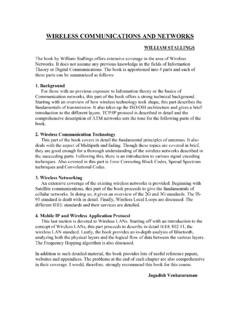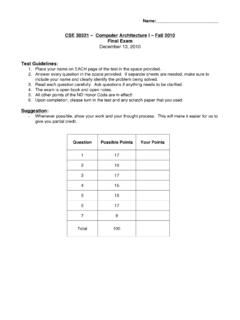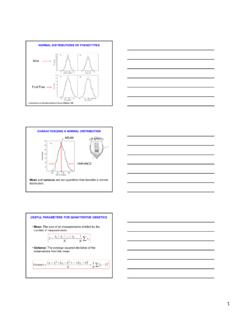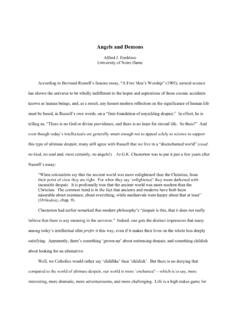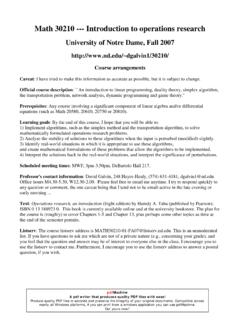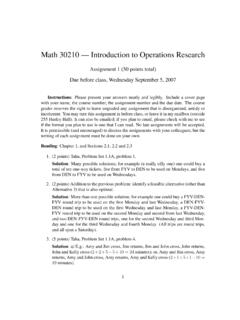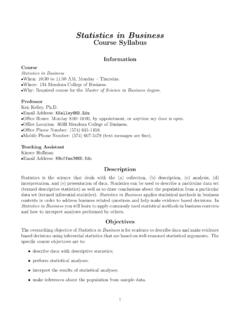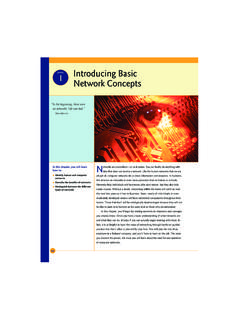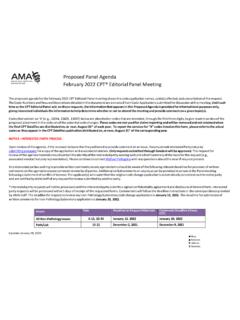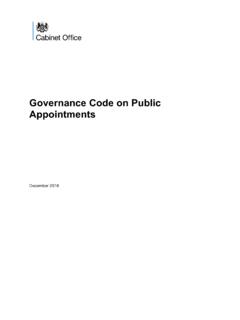Transcription of Panel Data 3: Conditional Logit/ Fixed Effects Logit Models
1 Panel Data 3: Conditional Logit / Fixed Effects Logit Models Page 1 Panel Data 3: Conditional Logit / Fixed Effects Logit Models Richard Williams, University of Notre Dame, ~rwilliam/ Last revised March 20, 2018 These notes borrow very heavily, sometimes verbatim, from Paul Allison s book, Fixed Effects Regression Models for Categorical Data. The Stata XT manual is also a good reference. This handout tends to make lots of assertions; Allison s book does a much better job of explaining why those assertions are true and what the technical details behind the Models are. Overview. In experimental research, unmeasured differences between subjects are often controlled for via random assignment to treatment and control groups.
2 Hence, even if a variable like Socio-Economic Status is not explicitly measured, because of random assignment, we can be reasonably confident that the Effects of SES are approximately equal for all groups. Of course, random assignment is usually not possible with most survey research. If we want to control for the effect of a variable, we must explicitly measure it. If we don t measure it, we can t control for it. In practice, there will almost certainly be some variables we have failed to measure (or have measured poorly), so our Models will likely suffer from some degree of omitted variable bias. Allison notes, however, that when we have Panel data (the same subjects measured at two or more points in time) another alternative presents itself: we can use the subjects as their own controls.
3 With binary dependent variables, this can be done via the use of Conditional Logit / Fixed Effects Logit Models . With Panel data we can control for stable characteristics ( characteristics that do not change across time) whether they are measured or not. These include such things as sex, race, and ethnicity, as well as more difficult to measure variables such as intelligence, parents child-rearing practices, and genetic makeup. This does not control for time-varying variables, but such variables can be explicitly included in the model, employment status, income. Examples (from Allison): Suppose you want to know whether marriage reduced recidivism among chronic offenders.
4 We could compare an individual s arrest rate when he is married with his arrest rate when he is not. The difference in arrest rates between the two periods is an estimate of the marriage effect for that individual. Or, you might see how a child s performance in school differs depending on how much time s/he spends playing video games. So, you could compare how the child does when not spending much time on video games versus when s/he does. Allison notes there are two conditions for using Fixed Effects methods. The dependent variable must be measured on at least two occasions for each individual. The independent variables must change across time for some substantial portion of the individuals.
5 Fixed Effects Models are not much good for looking at the Effects of variables that do not change across time, like race and sex. There are several other points to be aware of with Fixed Effects Logit Models . Panel Data 3: Conditional Logit / Fixed Effects Logit Models Page 2 The good thing is that the Effects of stable characteristics, such as race and gender, are controlled for, whether they are measured or not. The bad thing is that the Effects of these variables are not estimated. Again, it is similar to an experiment with random assignment. The Effects of variables not explicitly measured are controlled for (because random assignment makes the groups more or less similar on these characteristics) but their Effects are not estimated.
6 Other methods ( random Effects ) can be used when we want to estimate the Effects of variables like sex and race, but then the method is no longer controlling for omitted variables. Fixed Effects estimates use only within-individual differences, essentially discarding any information about differences between individuals. If predictor variables vary greatly across individuals but have little variation over time for each individual, then Fixed Effects estimates will be imprecise and have large standard errors. o Why tolerate the higher errors? Allison says there is a trade-off between bias and efficiency. Other methods, random Effects , will suffer from omitted variable bias; Fixed Effects methods help to control for omitted variable bias by having individuals serve as their own controls.
7 O Keep in mind, however, that Fixed Effects doesn t control for unobserved variables that change over time. So, for example, a failure to include income in the model could still cause Fixed Effects coefficients to be biased. o Allison likes Fixed Effects Models because they are less vulnerable to omitted variable bias. But he cautions that in applications where the within-person variation is small relative to the between-person variation, the standard errors of the Fixed Effects coefficients may be too large to tolerate. Conditional Logit / Fixed Effects Models can be used for things besides Panel Studies. For example, Long & Freese show how Conditional Logit Models can be used for alternative-specific data.
8 If you read both Allison s and Long & Freese s discussion of the clogit command, you may find it hard to believe they are talking about the same command! Example. Here is an example from Allison s 2009 book Fixed Effects Regression Models . Data are from the National Longitudinal Study of Youth (NLSY). The data set has 1151 teenage girls who were interviewed annually for 5 years beginning in 1979. The data have already been reshaped and xtset so they can be used for Panel data analysis. That is, each of the 1151 cases has 5 different records, one for each year of the study. The variables are id is the subject id number and is the same across each wave of the survey year is the year the data were collected in.
9 1 = 1979, 2 = 1980, etc. pov is coded 1 if the subject was in poverty during that time period, 0 otherwise. age is the age at the first interview. black is coded 1 if the respondent is black, 0 otherwise. mother is coded 1 if the respondent currently has at least 1 child, 0 otherwise. spouse is coded 1 if the respondent is currently living with a spouse, 0 otherwise. school is coded 1 if the respondent is currently in school, 0 otherwise. hours is the hours worked during the week of the survey. Panel Data 3: Conditional Logit / Fixed Effects Logit Models Page 3 We can use either Stata s clogit command or the xtlogit, fe command to do a Fixed Effects Logit analysis.
10 Both give the same results. (In fact, I believe xtlogit, fe actually calls clogit.) First we will use xtlogit with the fe option.. use ~rwilliam/statafiles/teenpovxt, clear . xtlogit pov hours , fe nolog note: multiple positive outcomes within groups encountered. note: 324 groups (1,620 obs) dropped because of all positive or all negative outcomes. Conditional Fixed - Effects logistic regression Number of obs = 4,135 Group variable: id Number of groups = 827 Obs per group: min = 5 avg = max = 5 LR chi2(8) = Log likelihood = Prob > chi2 = ---------------------------------------- -------------------------------------- pov | Coef.
